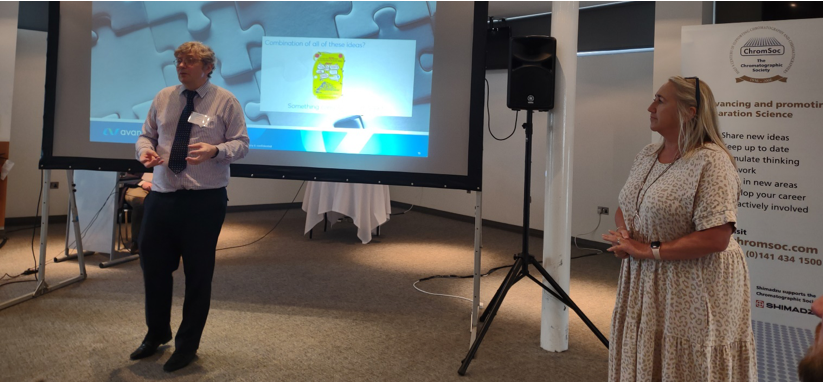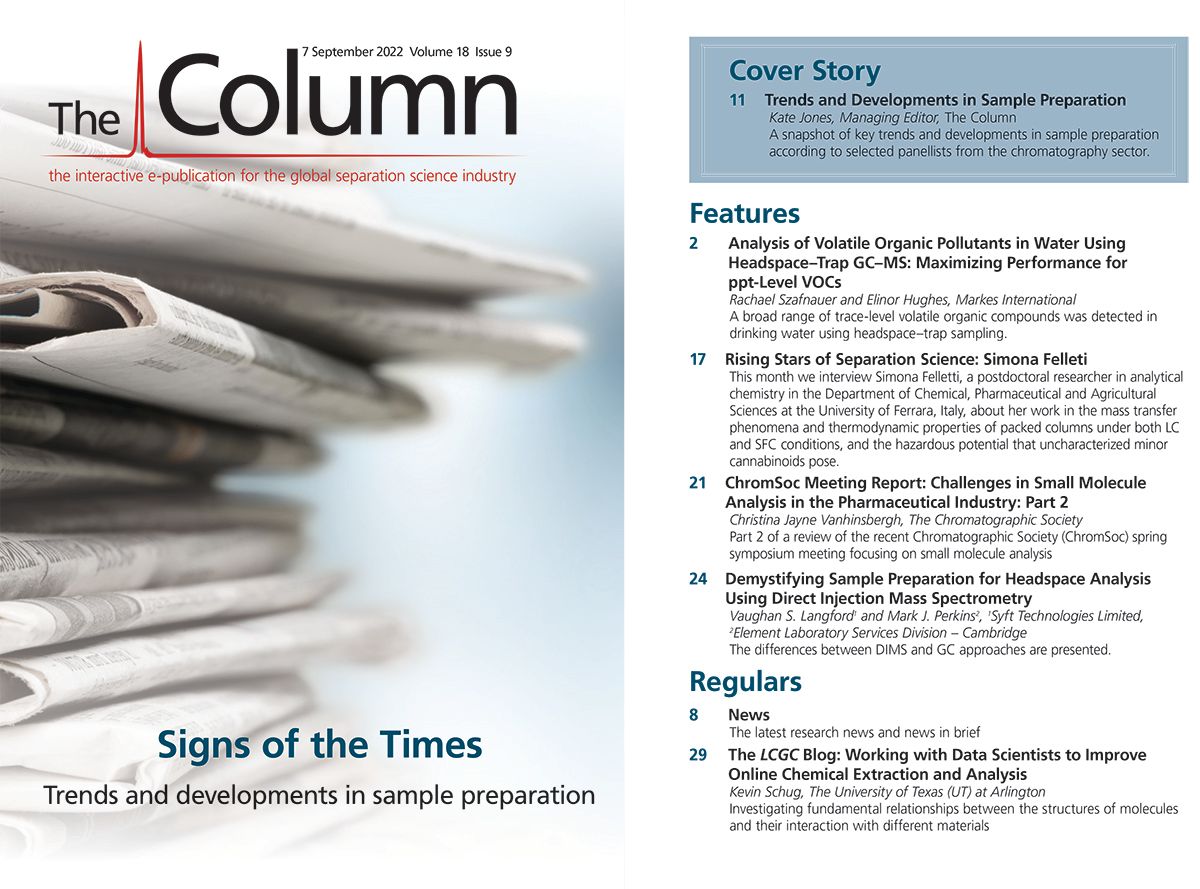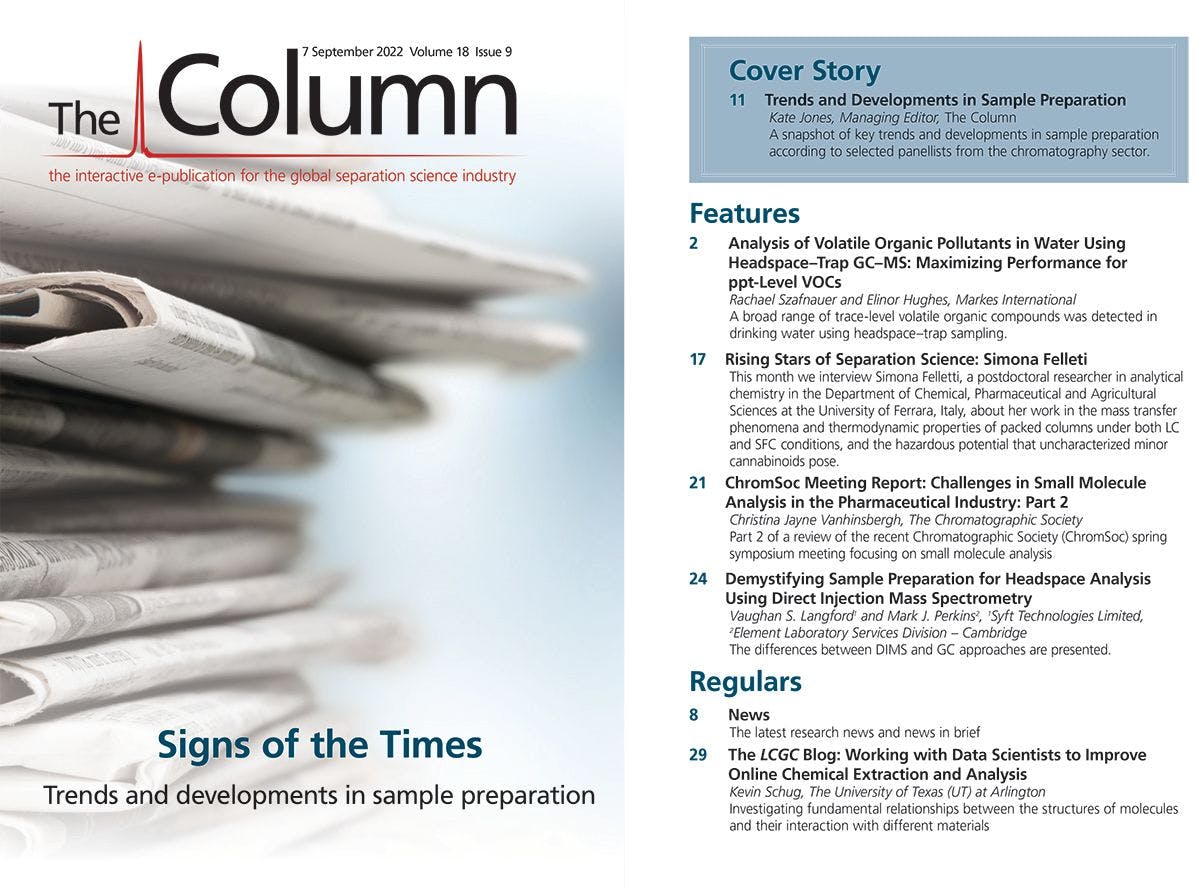ChromSoc Meeting Report: Challenges in Small Molecule Analysis in the Pharmaceutical Industry: Part 2
The final part of a review of the recent Chromatographic Society (ChromSoc) spring symposium meeting focusing on small molecule analysis.
Day 2 (20 May 2022)
Session 4: Challenges in Small Molecule Analysis: Polar and Chiral Compounds: John Lough from the University of Sunderland was the keynote speaker for the first session of day 2. His talk on “The Role of Chiral Screening in the Analysis of Small Molecules; Asymptotic Growth?” was an in-depth evaluation of chiral screening over the past two decades. By asymptotic, John meant a steady growth in throughput over time. John evaluated the current state of the art in chiral stationary phases and how columns and instrumentation have changed over the years. John discussed supercritical fluid chromatography (SFC) and how it became implemented in chiral screening strategies. He demonstrated the plethora of columns available for screening and the different methods he has utilized within his research. He added that even simple screens can be appropriate methods, as he demonstrated with his work screening anti-cancer compounds. John highlighted some future challenges for growth in chiral separations, such as the analysis of multi-chiral drugs, improvements in SFC technology, the development of tiered screens, and increasing throughput.
The next presentation was “The Dark Art of Chiral SFC” by Kiera Bailey from Reach Separations. Kiera explained that supercritical fluid chromatography harnesses supercritical fluids for separations as they have the low viscosity of a gas and the solubilizing power of a liquid. The high diffusivity value of CO2 leads to increased column efficiencies, which can then be used for chiral separations. Extensive screening approaches use 88 chromatographic conditions to find the optimal separation and, often, SFC is used over high performance liquid chromatography (HPLC) due to its higher throughput. Kiera presented some case studies of chiral and achiral separations and introduced the sustainability aspect of SFC: lower waste generation, usage of safer solvents, and renewable feedstocks—all of which will be potential analytical drivers in tomorrow’s world.
The final presentation of the session was from Luisa Pereira from Unilever, “Porous Graphitic Carbon—a Unique Stationary Phase for Challenging Separations”. Luisa presented an in-depth overview of the chemistry and retention mechanisms associated with this type of stationary phase. Porous graphitic carbon (PGC) is very pH-stable and highly retains polar analytes by inducing strong dipole–dipole interactions. She presented some case studies of separations, such as the separation of purines and pyrimidines using reversed-phase conditions, and commented on the complementarity between porous graphitic carbon separations and hydrophilic interaction chromatography (HILIC). Luisa also discussed high-temperature liquid chromatography using PGC stationary phase and just water for the mobile phase. High temperature separations demonstrate high efficiency, faster analysis times, and higher resolutions.

Session 5: Challenges in Small Molecule Analysis: Environmental Analysis: The keynote speaker for session five was Helena Rapp-Wright from Imperial College London, who presented a talk on “Analyzing Small Molecules in the Environment: Challenges and Opportunities”. She changed the title of the presentation to fit better to the theme and presented an engaging talk on characterizing contaminants of emerging concern (CEC). These CECs have the potential to be bioactive, entering the food chain and inducing antimicrobial resistance and other toxic effects. Helena’s work was to sample water routes around specific locations and analyze CECs using direct injection LC tandem mass spectrometry (MS/MS) and a 5-mm biphenyl stationary phase. Helena explained the method optimization strategy that facilitated the analysis of over 100 CECs in a 4-min run, allowing the analysis of 261 injections per day for high-throughput analysis. The case examples that she presented covered the analysis of pesticides and other toxic CECs, as well as illicit drugs within water effluent streams. Helena discussed how matrix effects can impede the sensitivity integrity of analytical data, and therefore her group has developed three-dimensional (3D)-printed passive sampling systems that capture CECs over a longer period and across a range of seasons to concentrate low-level analytes and increase sensitivity. She concluded that the increase in ability to characterize CDCs will be complemented by implantation of machine learning to large data sets in the future, and that biomonitoring remains challenging.
Following Helena, Simon Hird from Waters presented “Bringing Reliable Determination of Anionic Polar Pesticides in Food to the Routine Laboratory”. Simon introduced his talk by discussing food analysis and the challenges involved in extracting pesticides in food samples, such as getting the extraction technique correct to facilitate detection. The quick polar pesticides method (QuPPe) can extract multiple pesticides; however, it can be affected by LC–MS/MS matrix effects due to there being no sample clean-up step. LC–MS/MS analysis of pesticides found in food was performed using a HILIC/weak anion exchange (WAX) mixed-mode column originally designated for SFC, and great results were obtained from the phase chemistry. Simon presented a tool to investigate matrix effects and enable acquisition or multiple reaction monitoring (MRM) and full-scan data simultaneously. He concluded that flexibility is key for method optimization and that there remains the need to investigate improved sample clean-up options.
The final presentation was “Exploiting Flat Plate Heating to Double VOC Analysis Throughput, Whilst Improving GC Peak Shape for the Most Volatile Components”, by Bryan White from Agilent. Bryan quickly polled the audience to investigate how many of them use or have used gas chromatography (GC), and went on to argue how GC is not as challenging to approach as many might think. Cartridge‑type GC columns make installation much easier and, couple that with more user-friendly software, can help reduce operational errors. He discussed volatile organic compounds (VOC) analysis using flat plate heating technology, which can rapidly heat and cool to facilitate shorter analysis times. Faster temperature ramps can lead to band broadening, so shorter columns can overcome this and smaller column diameters can overcome
resolution limits.
Session five was followed by the Chromatographic Society annual general meeting where the society activities and expenditures throughout 2021 were described by Paul Ferguson, Tony Edge, and Greg Jonas.
Session 6: The Future of Small Molecule Analysis: Peter Myers from the University of Liverpool was the keynote speaker for the final session. His presentation “A World Without Chromatography” highlighted a vision to move away from the need to separate molecules. Peter talked about historical events, such as witnessing the birth of new detector types, and how people would attend symposia to witness technological breakthroughs. He argued that we haven’t moved on much from the observation of peaks in recent years and there is still so much we have the opportunity to do with technology. Peter introduced the idea of transitioning to pattern recognition and sensor technology for the future. He used many examples to highlight this concept, one of which was the “electronic nose”, which senses odours and identifies the pattern that is created. This technology is currently limited by a requirement for 1000s of sensors to match what we have naturally in the nose. He discussed the need to couple powerful computing with high-resolution sensors to understand complex patterns in the future, as well as alternative technologies for sensors, such as electrical pore wetting and de-wetting or nanowires. His key message was that if we can identify a sample pattern, then we would not need to separate the mixture using chromatography.
The final presentation was a closing discussion from Tony Edge, from Avantor, discussing “Chromatography of the Future”. Tony argued that chromatography is not dead and that we are actually on the cusp of something very exciting in the future. He discussed technological advancements, such as the development of sub-micrometre particles and the challenges they introduce to the field, such as increases in back pressure. We need faster chromatography and greater selectivity for complex samples through alternative approaches to separations. Tony identified the need for in situ analysis and instantaneous results, which may be facilitated by advancements in chromatography. He discussed future opportunities in modelling approaches to separations and improved stationary phase chemistries with defined pore structures to improve selectivity of complex mixtures. Printed or etched columns respective to our separation needs may be a product of the future, which might also further in situ analysis approaches. Tony also discussed high temperature analysis, which makes water behave more like an organic solvent and improves sustainability. He concluded with the idea that chromatography is a world full of opportunity!
To view the on-demand event, please click here: https://bit.ly/3bHD5II
Christina Jayne Vanhinsbergh is with The Chromatographic Society.
E-mail: enquiries@chromsoc.com
Website: www.chromsoc.com

Study Explores Thin-Film Extraction of Biogenic Amines via HPLC-MS/MS
March 27th 2025Scientists from Tabriz University and the University of Tabriz explored cellulose acetate-UiO-66-COOH as an affordable coating sorbent for thin film extraction of biogenic amines from cheese and alcohol-free beverages using HPLC-MS/MS.
Multi-Step Preparative LC–MS Workflow for Peptide Purification
March 21st 2025This article introduces a multi-step preparative purification workflow for synthetic peptides using liquid chromatography–mass spectrometry (LC–MS). The process involves optimizing separation conditions, scaling-up, fractionating, and confirming purity and recovery, using a single LC–MS system. High purity and recovery rates for synthetic peptides such as parathormone (PTH) are achieved. The method allows efficient purification and accurate confirmation of peptide synthesis and is suitable for handling complex preparative purification tasks.


















